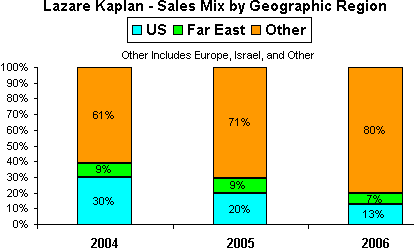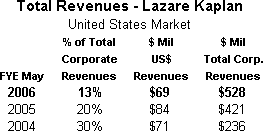IDEX Online Research: Lazare Kaplan - A Margin Squeeze That Could Get Worse
November 20, 06
Lazare Kaplan’s loss for its first fiscal quarter ended August 2006 was the first time management had reported an unprofitable August quarter in seven years. Like most diamantaires, Lazare Kaplan is undergoing change, some brought about by management, and some brought about by the industry.
In his letter to shareholders, Lazare Kaplan chairman Maurice Tempelsman talked about “a dysfunctional pipeline” that was brought about by “a series of unjustified and excessive price increases by rough diamond producers driven by cyclical euphoria.” In his comments about the company’s performance during the August quarter, Lazare Kaplan vice chairman Leon Tempelsman went a step further when he said, “In our view, all of the large rough diamond producers, including the DTC, have increased rough prices to non-sustainable levels over the past several years, which has led to increasing pressure on margins throughout the diamond pipeline . . . .”
Clearly, Lazare Kaplan has been a victim of the margin squeeze. For its August quarter, its pretax margin fell to a loss of 1.7 percent. Further, for its fiscal year ended May 2006, its pretax margin was 0.1 percent - one-tenth of one percent. Not only is the trend unfavorable, but sound business judgment cannot justify continuing to operate a business with these margin trends. While Lazare Kaplan is the only public company in its particular niche in the diamond pipeline, others tell us of similar margin pressures.
During the August quarter, Lazare Kaplan’s polished diamond margins fell to 9.3 percent from mid-teen levels in prior quarters. Further, its rough trading margin fell to 1.3 percent from as high as 5 percent a few years ago. Management cited several factors which put pressure on margins, including the following:
- Reduction in liquidity throughout the diamond pipeline due to tightening by banks and other lenders.
- An unsustainable price policy for rough diamonds by the major rough producers and the inability of suppliers to pass along price increases through the diamond pipeline.
- Concerns about the direction of the consumer markets related to 1) political uncertainties; 2) uncertainties about housing values; 3) higher interest rates; 4) oil price uncertainty; and 5) the strong possibility of a late holiday selling season.
Further, while Lazare Kaplan appears to have a diverse portfolio of businesses, none of them is operating on all eight cylinders. Management kept using the statement “things are progressing” which is a euphemism for “we’re not there yet” when it talked about its operations in South Africa, Namibia, Angola, Russia, and Botswana. With the unsettled political climate in Russia, it is possible that the company’s decade-old relationship with Alrosa – a reasonably solid relationship, given the circumstances – may be in jeopardy. Further, operations of its Bellataire line of enhanced diamonds appear to be stalled.
Geographically, management said that its business in Southeast Asia was growing, with “long term promise.” That’s another euphemism for “we’re not there yet.” In Japan, its business is showing slow but steady growth.
In the U.S., management acknowledged that its business has been challenging. It cited American retailers as being conservative with their re-stocking plans and waiting until very late to buy goods, especially for the upcoming holiday selling season. In the company’s annual report (10-K) filed with the Securities and Exchange Commission, it acknowledged that its business in the U.S. has fallen off. The following graph illustrates the percentage of its total business done in the U.S. by year has declined sharply.

Source: Form 10K
In addition, as the following table illustrates, its total business in the U.S. market, as measured in dollar-based revenues, also declined sharply in 2006.
|
|
What is the company going to do about this trend? In its letter to shareholders, management says the following:
“The company has rationalized and simplified its jewelry offering in the United States and abroad. The company expects to drive that segment of the business, as well as accelerate the roll-out of LKI boutiques and self-standing stores – and initiative that has shown considerable success, particularly in Southeast Asia.” Could that mean that Lazare stores might appear in the U.S., perhaps on New York’s Fifth Avenue near the De Beers LV store and Tiffany?
Proxy Fight Possible
It appears that Lazare Kaplan could be headed for a proxy fight with Fifth Avenue Group which holds 26.2 percent of the company’s stock (and voting power). The company’s proxy identifies Matthew Fortgang and Susan Fortgang as the beneficial owners of these shares. The Fortgang's, who are brother and sister, are top executives in the family-owned business, M. Fabrikant & Sons, a DTC sightholder and global diamond supplier that recently filed for Chapter 11.
It appears that not only has Fifth Avenue overstepped its standstill agreement to maintain its holdings below 24.9 percent, but in September, 2006, Fifth Avenue filed a complaint seeking a judgment that its stock is not “restricted” stock (under Rule 144[k], meaning it cannot be freely traded in the market), and that any subsequent purchaser of such share would not be subject to an irrevocable proxy granted to Messrs. Maurice and Leon Tempelsman by Fifth Avenue in connection with a private sale.
Again, reading between the lines, Fabrikant has been undergoing some financial restructuring, so it may be trying to liquefy this securities holding. If the stock is deemed both “restricted” (under the SEC definition) and carries an irrevocable proxy granted to the Tempelsman family, it would likely be devalued significantly below the current market price. Lazare Kaplan has said that “the company intends to vigorously pursue all defenses and counterclaims available to it.” In short, the Tempelsman family, which currently controls about 60 percent of the vote of the company, including the Fifth Avenue holdings, could be reduced to a minority position, if Fifth Avenue is able to eliminate the irrevocable proxy which it granted the Tempelsman family.
Other directors and officers own less than 4 percent of the company’s shares; thus, control of the company would clearly be in the hands of outside shareholders, if Fifth Avenue wins its suit. The company’s board currently consists of Maurice Tempelsman, age 77, Leon Tempelsman, age 50; Lucian Burstein, age 84; Myer Feldman, age 89; Richard Berenson, age 71; and Robert Del Genio, age 48. We believe that if control of the company moved to the outside shareholders, it is likely that the composition of the board would change.
